Pelargoniums, for a long time popular potted and garden plants across the world, have been in cultivation since the early 1700s. Of the 270 or so wild species of pelargonium, about 220 are native to South Africa. In addition to these wild species, many cultivars have been developed since pelargoniums have been in cultivation in Europe and elsewhere.
Although cultivars are popular in South Africa, indigenous species are also grown in many gardens and they continue to grow wild in their native habitats. One of the more conspicuous examples is the showy and shrubby Pelargonium cucullatum (see the photograph above). It occurs naturally on sandy and granite slopes in coastal areas and the adjacent mountains in the southwestern Cape, ranging from Saldanha Bay in the northwest and southerly to Gansbaai and the adjacent interior.

In the wild the flowers can vary in colour from white through pink to mauve. The flowers of the Pelargonium cucullatum in these photographs I photographed in the Hermanus region of the Western Cape
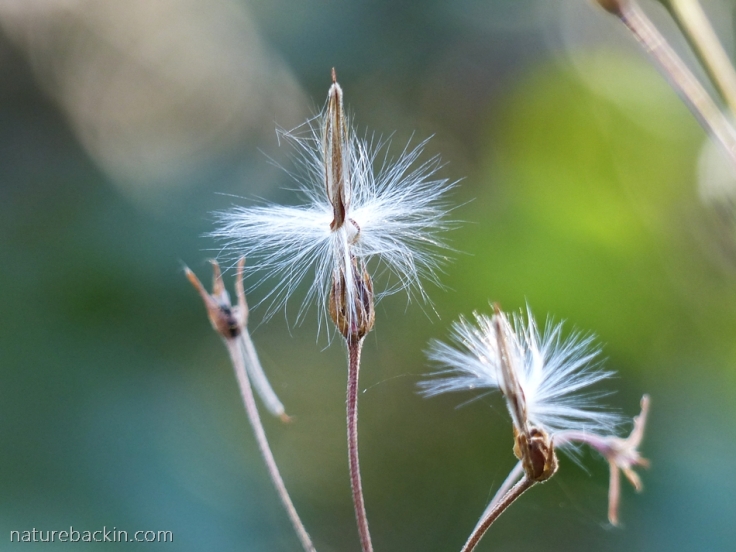
The wind-dispersed fluffy seed of the Pelargonium cucullatum
Samples of Pelargonium cucullatum were first taken to Europe in 1672 by the Leiden-based Dutch botanist Paul Hermann. He collected these samples from plants growing on the slopes of Table Mountain in Cape Town. Perlargonium cucullatum is the ancestor of many modern cultivars and hybrids known as regal pelargoniums.
The leaves of Perlargonium cucullatum produce a sweet smell when crushed, and they are used in a traditional medicine for coughs and chest congestion. The name of the plant derives from the Latin word cucullatus, meaning a cape or cowl, reflecting the cup-shaped leaves. Common names for the plant include hooded-leaf pelargonium and wild malva.

The pink flowers of the Perlargonium cucullatum are visible amongst the fynbos vegetation growing below the Kleinrivier Mountains near Hermanus in the Western Cape
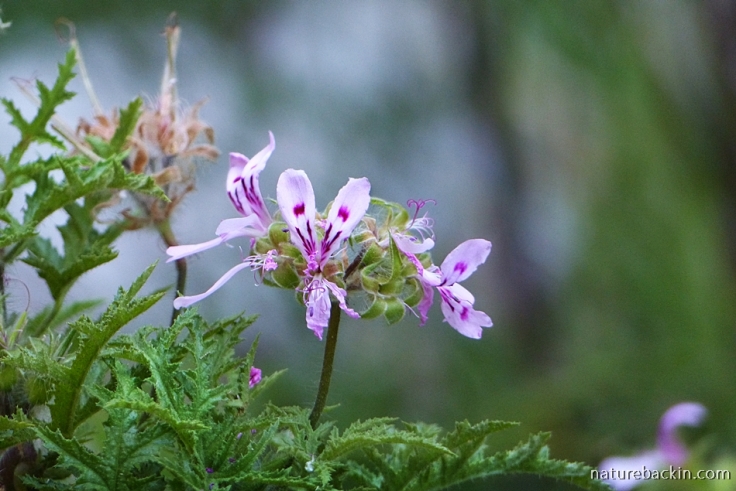
Above is another example of a wild species of pelargonium, which I photographed growing wild in a narrow kloof (gorge) between steep rock faces in the Gamkaberg in the Western Cape

As we walked through the narrow gorge we were observed from on high by a troop of baboons looking down on us. This young baboon had picked a small branch off a succulent plant (probably Crassula arborescens) before settling down to eat the stem

Also in the Gamkaberg, another pelargonium – this one with a delicate white flower streaked with pink at the centre – grows in the protective dappled shade and shelter of the kloof, which accommodates a diversity of plants that do not grow on the exposed rock faces and vegetated outcrops
Most of the cultivated pelargoniums that are grown today derive from South African species. One of the first zonal pelargoniums sent to Europe was collected in 1689 by the German-born and Netherlands-educated physician and botanist Hendrik Oldenland, in Meiringspoort. Trained by the Leiden-based botanist Paul Hermann (who collected the Perlargonium cucullatum samples from Table Mountain), Oldenland came to the Cape as an employee of the Dutch East India Company. From Cape Town he participated in an expedition into the Karoo, being one of the first trained botanists to collect wild plants in this region. He was a serious collector, cultivator and recorder of South African indigenous plants, and his work included establishing a herbarium at the Company Gardens in Cape Town.

The pass through the Meiringspoort in the Western Cape nowadays is a tarred road that runs parallel to the river. Nevertheless, in times of heavy rains it is not unusual for the road to be closed as a result of flooding down the gorge

Roadside vegetation in Meiringspoort includes zonal pelargoniums similar if not the same as those collected by Oldenland on the expedition over 300 years ago

These robust pelargoniums growing in Meiringspoort are tall and shrubby, though recognizably similar to the smaller potted varieties and hybrids grown indoors and suited to very different circumstances to the rugged extremes of the Karoo
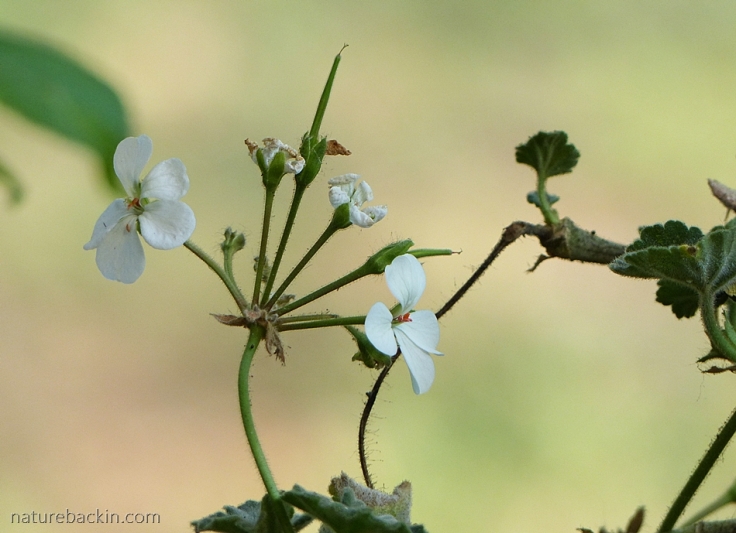
Both the genus Pelargonium and the genus Geranium belong to the Geraniaceae family. Initially the two genii were not differentiated, perhaps explaining why pelargoniums are still commonly although incorrectly referred to as geraniums. The term Pelargonium derives from the Greek word pelargos, which means stork, as the shape of the fruit or seed capsule is thought to resemble the beak of a stork. In the photo above, the beak-shape of the fruiting flower can be clearly seen in this white-flowered pelargonium from the Eastern Cape
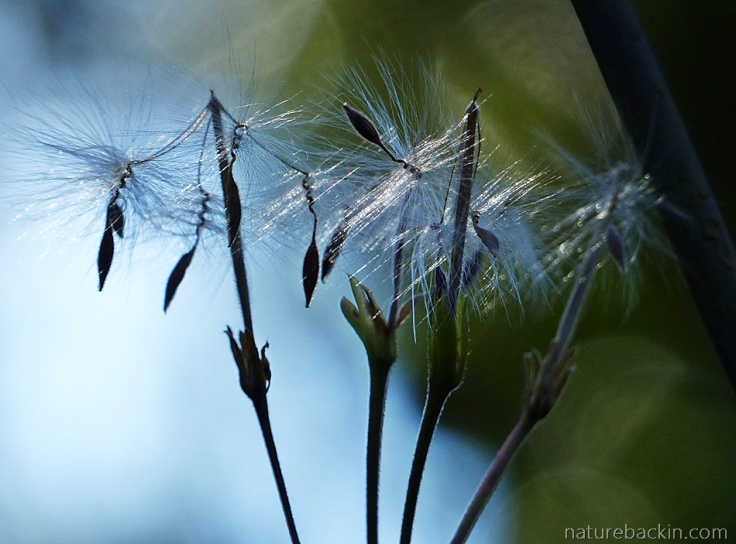
The seeds of pelargoniums are adapted for dispersal in the wind – they are light and feathery and so float in the breeze. Each seed has a spiral “tail” – after the seed lands on the ground when twisted in the wind the spiral effectively “cork screws” the seed into the ground. The above photo shows these seed characteristics in a Pelargonium tongaense growing in our garden
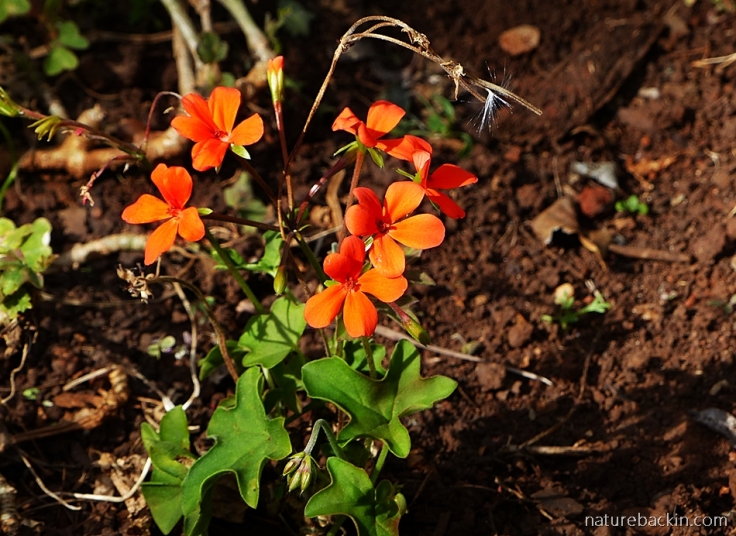
This Pelargonium tongaense in our garden sports a bud, flowers and seedhead all on one plant. In the wild the species Pelargonium tongaense is endemic to a small area of northeastern KwaZulu-Natal (in Tongaland). It was formally described as a species only as recently as 1981
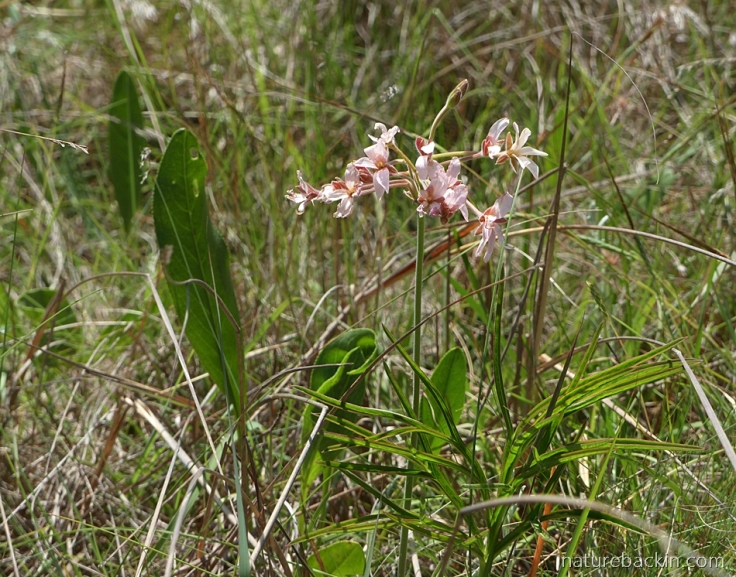
Growing wild in a patch of indigenous grassland in the KwaZulu-Natal (KZN) Midlands is this pink-flowered Pelargonium luridum (see above). Pictured below is a white-flowered variety also growing wild in the KZN Midlands. In traditional medicine the leaves are used to treat stomach upsets and dysentery

Another grouping comprises the semi-climbing ivy-leafed pelargoniums. The indigenous Pelargonium peltatum grows wild, scrambling in coastal scrub, along the southern coast of the Western Cape and east towards East London. Its ivy-shaped leaves are semi-succulent. Many cultivars and hybrids derive from this plant and some of these are popular planted in hanging baskets and window boxes, and they can also be used as a ground cover.
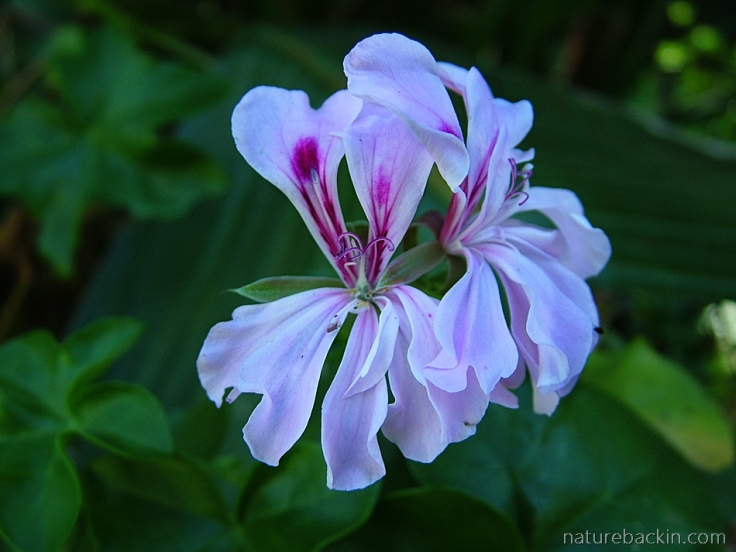
I think this plant, that used to grow against a fence in our garden, is the indigenous Pelargonium peltatum, but it may be a cultivated variety. Unfortunately, this one did not survive being cutback and transplanted when we had to move the fence, and neither did any of the cuttings
Also notable among pelargoniums are the many scented varieties with their highly aromatic foliage. Traditionally, some of the scented-leaf pelargoniums were used as perfumes in South Africa. One of the best known is the indigenous rose-scented variety, which we used to have growing in a pot in our garden, but not currently – something I need to remedy. We do, however, have a small cultivated variety reputed to be cinnamon scented.

The scent is certainly strong, but I am not convinced that this little cultivated pelargonium smells like cinnamon as is claimed for it, but the dainty flowers are definitely pretty
There is much more that can be said about the attractive, diverse and easy-to-grow pelargoniums. Instead though, I will finish off with some photos of cultivars and hybrids of zonal pelargoniums that we have growing in pots outside our house. All of these are survivors. Many gorgeously flowering potted plants that we bought at markets proved to be very short-lived, so now I stick with these survivors and the little P. tongaense that grows out in the garden.
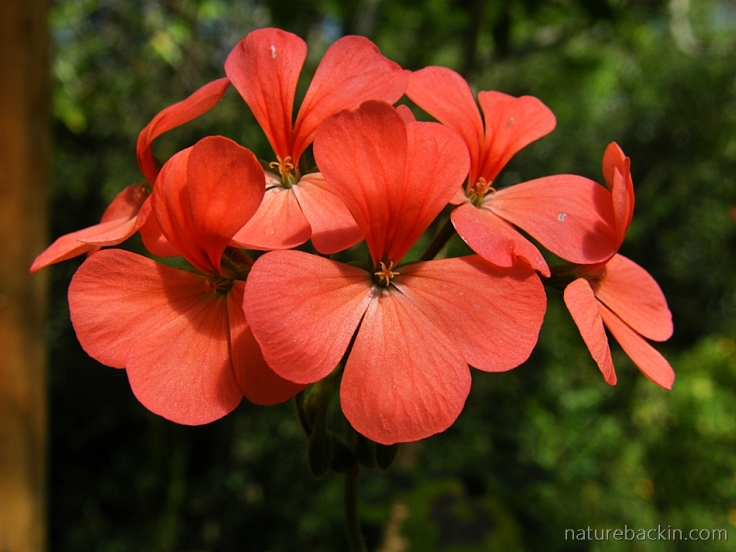
A lovely salmon-hued zonal pelargonium that has been growing in a pot on our back deck for over ten years, flowering reliably each year
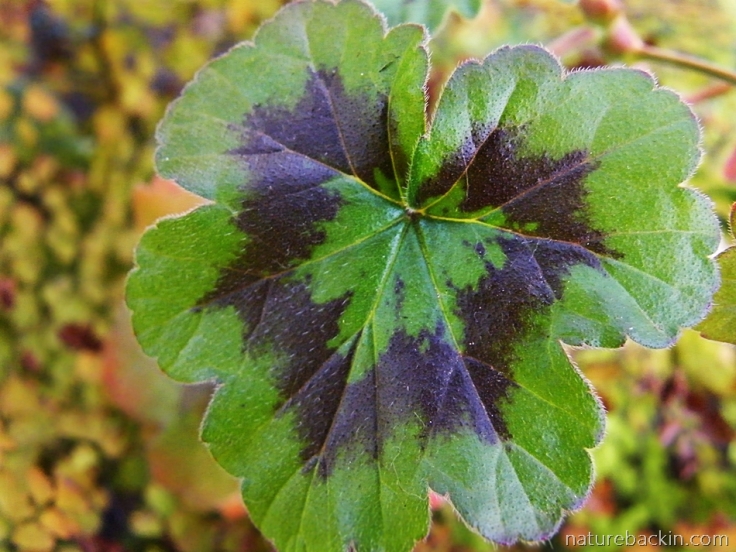
Zonal geraniums are so called because the leaf has zones or patterns in the centre of the leaves, as can be seen in this leaf that belongs to the salmon-coloured flowering plant pictured above

I wish I knew the name of this distinctive zonal pelargonium that has been a reliable survivor in a pot on our back deck for a number of years

Sources: Van Wyk, Ben-Erik and Gericke, Nigel. 2007. People’s Plants: A Guide to Useful Plants of Southern Africa. Pretoria: Briza; Mukoma, T. 2004. Pelargonium tongaense. PlantZAfrica. South African National Biodiversity Institute (SANBI). http://pza.sanbi.org/pelargonium-tongaense; Plug, C. 2014. Oldenland, Mr Heinrich Bernhard (botany). S2A3 Biographical Database of Southern African Science. https://www.s2a3.org.za/bio/Biograph_final.php?serial=2062; Wikipedia. 2019. Perlargonium. https://en.wikipedia.org/wiki/Pelargonium
Posted by Carol









May 25, 2019 at 6:53 pm
A stunning selection of photos Carol! Those colours are so vibrant!
LikeLike
May 26, 2019 at 2:48 pm
Yes the colours can be exceptional. Thanks very much Pete, and lovely to hear from you.
LikeLiked by 1 person
May 26, 2019 at 3:37 pm
You are welcome Carol, and thank you.
LikeLiked by 1 person
May 25, 2019 at 4:20 am
I had no idea there were so many Pelargoniums in the wild. This is a marvelous post and the pics are superb.
LikeLiked by 1 person
May 25, 2019 at 6:07 am
Thanks so much MPP. Pelargoniums are so domesticated it is quite surprising to connect them to their wild ancestors!
LikeLiked by 1 person
May 24, 2019 at 1:53 pm
Yet again a wonderful post. I had no idea there were so many species of pelargonium. Brilliant such a gift with words too. 😘
LikeLiked by 1 person
May 25, 2019 at 6:03 am
Thanks so much Debs. Yes it is amazing there are quite so many wild species in SA and that they are so diverse too.
LikeLike
May 24, 2019 at 12:58 pm
Such an interesting read, about plants which are so familiar here and are of course just coming back into hanging baskets and pots ready for the summer. And now I understand the confusion with geraniums and pelargoniums. Beautifully illustrated as always, Carol. Thank you 🙂
LikeLiked by 1 person
May 25, 2019 at 5:40 am
We grew up calling the potted plants geraniums, which has a different resonance to the correct name. Those baskets of mixed flowering plants are such a nice custom to celebrate summer. Thanks Sandra.
LikeLiked by 1 person
May 24, 2019 at 11:02 am
Nice Pics of pelargoniums, especially likes the ones you photographed in Hermanus mountains. Plenty of those around the corner here in Onrus as well. We were amazed to see the wonderful hybrid examples hanging from baskets in Spain.
LikeLiked by 1 person
May 25, 2019 at 5:35 am
Thanks Suzette. In fact the header pic was taken in Onrus. I am imagining those hanging baskets in Spain. It is nice that pelargoniums seem to have been wholeheartedly embraced in so many cultures and countries where they have been so cheerfully domesticated.
LikeLike
May 24, 2019 at 6:06 am
Pelargoniums are popular as pot plants here, but it never occurred to me that the originals come from your part of the world. The variety to be found in the wild is astonishing. What an interesting post
LikeLiked by 1 person
May 24, 2019 at 4:14 pm
Thanks Margaret. I love the way pelargoniums have become such a cheerful tradition being used as pot plants in the UK and elsewhere, including in many Mediterranean countries.
LikeLiked by 1 person
May 24, 2019 at 6:04 am
First time I’ve ever seen the word ‘pelargonium.’ I guess I’ve lead a sheltered life! Lovely variety of flowers though and how interesting to see them in your garden and in their native habitat.
LikeLiked by 1 person
May 24, 2019 at 4:11 pm
Thanks Graham. Despite being sheltered from the word, I imagine you are nevertheless familiar with the plant?
LikeLiked by 1 person
May 27, 2019 at 6:33 am
To be honest, I’m not sure. Probably some of the plants I knew as geraniums were actually pelargoniums, but I couldn’t say for sure.
LikeLiked by 1 person
May 24, 2019 at 6:00 am
Awesome pictures.
LikeLiked by 1 person
May 24, 2019 at 4:09 pm
Thanks so much Kamal.
LikeLike
May 24, 2019 at 4:10 pm
Welcome dear.
LikeLiked by 1 person
May 24, 2019 at 5:16 am
Loved reading this – very informative – lovely pics!
LikeLiked by 1 person
May 24, 2019 at 4:09 pm
Thanks so much. I think many people are fond of pelargoniums.
LikeLike
May 24, 2019 at 4:36 am
Beautifully documented Carol, packed in a lot of information and lovely to see the wild plants in situ, especially in the Gamkaberg and Meiringspoort. Area. Nice to see the baboon pic too high up in the crags. Such a rewarding species to grow and interesting to see the KZN species.
LikeLiked by 1 person
May 24, 2019 at 4:08 pm
Thanks so much Liz. I wish now I had been more observant of such plants when we visited the Cape. The baboons at Gamkaberg were lovely to watch – we sat quietly for well over an hour while they looked down on us while foraging, grooming and playing, and one of them even managed to take a long nap while sitting up near the edge of a cliff!
I also love pelargoniums and its so interesting to see how they have been embraced in other countries where they have become quite traditional.
LikeLiked by 1 person
May 24, 2019 at 3:35 am
And yet another fascinating and beautiful post. It’s tempting to think of planting some of these beauties though I am trying to revert the land to more native species. Perhaps a small one for indoors?
One of the “related” posts suggested by WordPress is your Agapanthus. Eric calls it the Angry Panther. I successfully transplanted one from a previous house and it seemed to do really well, but then didn’t bloom this year. I’m wondering if perhaps it didn’t like having its blossoms nibbled off by deer last summer. I planted it before I tilted toward trying to go native as much as possible.
LikeLiked by 1 person
May 24, 2019 at 3:57 pm
Sounds like a small one indoors is an excellent compromise!
Re the non-flowering Angry Panther – they are used for cut-flowers here without impeding subsequent flowering, and I imagine the deer are behaving a bit like florists – except that they eat the blooms they remove rather than displaying them 🙂 Is there more shade around your plant this year? Not enough sun seems to be a big factor in them not flowering, though water and temperature are likely also significant factors I should think.
I hope that you are enjoying experimenting with gardening with native plants – its adds so many interesting dimensions and diversity to the garden and makes a refreshing change from the oh-so-similar gardens we are most accustomed to seeing the world over.
LikeLike
May 26, 2019 at 1:34 am
Ahah! Did some weeding today and discovered a flower stalk on the Angry Panther hiding in plain sight. If my eyes let me, I might try to post it to show you! I’m wondering if it might be because our springtime has been rather unusually delayed this year. It gets plenty of sunshine on the rock garden we created on the side of the hill. From my experience with it at the previous house, it did quite well with our current climate, but failed to bloom if we had an unexpected frost during the winter. (I usually try to give it some protection when a freeze is expected.) It looks like it’s already trying to spread out in the rock bank… it has me wondering if it was such a great idea to plant it there? 😉
LikeLiked by 1 person
May 26, 2019 at 7:09 pm
Nice to know it is producing a flower despite the late spring. If it starts spreading too exuberantly maybe it could be confined to a pot?
LikeLike
May 24, 2019 at 2:12 am
What a beautiful feast, Carol!
I liked having pelargoniums in our garden – unfortunately Joubert’s pet rabbit loved them even more, consuming whole plants – roots, stems, leaves, flowers – in the blink of an eye!
LikeLiked by 1 person
May 24, 2019 at 3:48 pm
A beautiful feast indeed, for a rabbit! I am quite surprised the rabbit likes them as they can be so strongly scented. Perhaps you can find a rabbit-proof pot so you can have at least one pelargonium in the garden?
LikeLiked by 1 person
May 25, 2019 at 1:53 am
Their strong smell is exactly the reason I had thought they’d be rabbit-safe too. Toe nou nie! The little rabbit has since moved off the mortal coil (through old age) and perhaps we should try to plant a few again – we love our little water-wise indigenous garden.
LikeLiked by 1 person
May 23, 2019 at 10:00 pm
Where would we be without Pelargoniums? Probably the most widely grown annual in the world. I grow several (ivy, zonal and scented) as they are tough enough to withstand my cool sunspace in winter (where the temps can dip into the 40s) and continue to bloom.
I have the same one as in your last photo – it’s Stellar Pelargonium ‘Vancouver Centennial.’
LikeLike
May 24, 2019 at 3:45 pm
Yes, pelargoniums seem to be everywhere. Thanks very much for the ID – I guess that “Stellar” might refer to the star-shaped leaves and flowers.
I double took at you describing pelargoniums as annuals as here they are perennials – I guess those growing outdoors in winter in your part of the world are rendered annuals by the frosts and snow.
LikeLike
May 24, 2019 at 6:10 pm
No, they don’t like our freezing temps at all!
LikeLiked by 1 person
May 23, 2019 at 9:38 pm
Lovely pics! 🙂
LikeLiked by 1 person
May 24, 2019 at 3:38 pm
Thanks very much M.B.
LikeLiked by 1 person